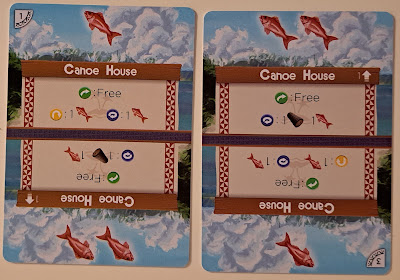Palm Island designed by Jon Mietling and published by Portal Dragon
Palm Island came from an idea that was profound in its paradoxical promise--what if there were a table-top game that didn't need a table? Not even an airplane tray-table or a car dashboard? This game is a small deck of cards (17) that the player holds in their hand. As play proceeds, cards are turned to the side, flipped upside down, or flipped over to show the player's progress. Thematically, the player is developing their tropical island from primitive conditions to a higher state of development. Don't expect skyscrapers here, but do look forward to developing nicer homes and houses of worship.
The game play is remarkable simple. Cards are oriented in their starting position, with a little sun symbol in the top left corner that also includes the card number.
 |
| Canoe cards, the second one is in the wrong orientation! |
| The round tracking card |
Then they are shuffled and the round tracking card is placed at the back. The player looks at the first two cards and has the choice of activating either card and moving it to the back OR of moving the first card to the back in an upright position. There are three possible activations (though some cards have zero, one, or two options):
- Store--a green arrow pointing left indicates the card should be rotates 90 degrees clockwise and put in the back of the deck. The resource or resources listed on the top of the card can now be used to pay for activations.
- Rotate--a yellow upside down U arrow indicates the card should be rotated 180 degrees and put in the back of the deck. The card now has a better power or is worth more victory points (or maybe both!).
- Flip--a blue circular arrow indicates the card should be flipped over and put in the back of the deck. Again, the card has an upgraded power or victory points or both.
Activations typically have a cost printed next to the arrow symbol (unless it says "Free" of course).
 |
| A Canoe House that used its Store activation |
The game proceeds as the player generates resources and upgrades the various cards, like the Canoe House (to get more fish) or the Quarry (to get Stone) or the Temple (to get more victory points). If a resource card (i.e. one at a 90 degree angle) ever is the top card of the deck, that resource has to be used immediately or it is lost--the card goes to the back of the deck straight up. So it's important to spend those resources! Also, the player is only allowed to have four resource cards at a time, forcing occasional tactical decisions.
By the end of eight rounds (which is going through the deck eight times), the island is in much better shape than when the player started. Victory points (listed in the middle of the card next to a yellow star) are counted up.
In my first game, I scored 38 points, which seems like a lot for a first time. That's Exceptional according to the rule book chart, two points below Astounding, which is 40+ points. Maybe I was doing something wrong? Or I just had a preternatural grasp of the game? I double checked the rules and think I might have not been putting rotated or flipped cards in the back of the deck. Playing again, I scored 33 points, so still a very good score. Things evened off after that, scoring in the high twenties.
The game includes special feat cards that can be added to the original deck to make the game different. One cards lists all the feats and different criteria for each feat. The feats add new goals and powers to the solo game and provide a little extra variety. The first listed is "Statue of Trust" and is earned with a score of 30 or higher.
 |
| Feat index and a couple of the cards (click to enlarge) |
The game includes a second deck of 17 cards to play cooperatively or competitively. In cooperative mode, the players select a disaster card (Famine, Eruption, or Hurricane) and must collect resources to defeat those cards. They also have the option of adding Cooperative Ability cards to make things more interesting. In competitive mode, one player randomizer their deck and then the other player matches the randomization, using the card numbers in the top left corner. The players add some Outpost cards and optionally some Villagers that can be bought at the end of rounds, if they have the resources. I did not try any of the two-player modes, so I can't comment on them.
The game also includes a nice, sturdy wallet to carry the game around, like on vacation or running errands. There's even a "Plastic Card" edition for extra durability.
I have enjoyed my plays of this game solo and look forward to trying out the feats, when I start earning them.
Recommended.




No comments:
Post a Comment